Remembering: Monty Python and the Holy Grail
The English comedy troupe invaded America in 1975 with arguably the funniest movie ever made.
When the topic of “funniest movie of all time” rolls around, the usual suspects come to mind … genre parodies produced by America’s comic emeritus Mel Brooks (Blazing Saddles, Young Frankenstein, The Producers), the one-liner gag specialties (Animal House, Airplane!), mockumentaries (This is Spinal Tap, Best in Show), smart, searing satire (Dr. Strangelove, Borat!) and the quirky cult classics (The Big Lebowski, There’s Something About Mary).
With due respect to Brooks, the Coen brothers and “The Dude,” nothing has assaulted my funny bone harder and more relentlessly than Monty Python and the Holy Grail (1975). This low-budget, audacious smackdown of Arthurian legend melds all the essentials of comedy – irony, absurdity, incongruity, hyperbole and sarcasm – brilliantly written and produced by the British comedy troupe Monty Python.
The Pythons — John Cleese, Eric Idle, Graham Chapman, Terry Jones and Michael Palin and Terry Gilliam (the lone American) — were at their nadir with their BBC television sketch comedy series Monty Python’s Flying Circus (1969-73). Though wildly popular in the U.K., the Pythons were largely unknown in the United States.
It wasn’t until KERA-TV, the public television station in Dallas, was the first station in the country to broadcast this unknown program on a Sunday evening in the Fall of 1974 to a very unsuspecting, post-Masterpiece Theater audience. Almost instantly, the Monty Python’s Flying Circus phenomenon was born.
The arrival of Monty Python and the Holy Grail was fortuitous timing.
How The Holy Grail came about
Though highly popular in England, collectively the Pythons were far from wealthy. Outside financing was required as the film was conceived. In scraping together the funds to make The Holy Grail, Monty Python shot for the moon. Ironically, some of the “Money” came (literally) from the Dark Side of the Moon.
Members of Pink Floyd were fans of The Flying Circus, and £31,000 of proceeds from the album The Dark Side of the Moon was secured. It turns out other rock stars were Python fans. Members of Led Zeppelin and Ian Anderson of Jethro Tull also contributed, as did the Chrysalis and Island record companies. Final original budget: £319,000, a paltry sum by today’s standards.
Limited funding forced many compromises for producers and crew. For example, the budget didn’t allow enough money for the procurement and care of real horses. So the Pythons resourcefully turned the shortfall in their favor through a bit of scripting ingenuity.
Lacking equine mobility, characters would instead traverse about scenes on foot, prancing with a rhythmic gait, with servants creating the sounds of galloping hooves by clapping together coconut halves. Comedic gold. Appropriately, the Pythons promoted the film’s premiere by giving away coconuts.
Writing: The Legend of King Arthur
The Holy Grail concept originated in 1973 as the troupe wanted to expand out from its successful sketch comedy format featured in The Flying Circus. Writing began early in ‘73 during a hiatus from television production.
Collectively they chose the historic legend of King Arthur, Camelot and the Knights of the Round Table as the central plot. Historical events and period pieces were frequent topics on The Flying Circus, and the Pythons were masters at exploiting humorous themes.
Cleese had taken a sabbatical from The Flying Circus between Seasons 3 and 4, citing creative differences. He rejoined the Pythons for The Holy Grail. As they did with the television series, members worked in collaborations – Cleese and Chapman wrote together, with Jones teaming with Palin. Gilliam – an animator and art director – worked on his own due to the nature of his work. Idle also wrote solo. They convened periodically to craft individual scenes.
After several iterations, a finalized script came together. The lead role of Arthur fell to Chapman. Idle and Cleese later revealed that Chapman by far was the most accomplished actor. Born in Leicester in Central England, Chapman attended Cambridge and St. Bartholomew College, from where he earned a medical degree in the early 60s.
Arthur’s character necessitated a commanding presence. Chapman fit the part. He was 6-foot-2, and his physique and poise carried an aura of royalty. He spoke with a classic formal “Cambridge” accent and had trained with the Footlights theater group while at Cambridge. Though funny, he served primarily as a straight man with whom the other characters played off for the best lines. All of the Pythons played multiple roles.
Directing, Roles and Filming
The original plan was to film large portions at various castles around the United Kingdom. But shortly before production began, the U.K. government withdrew filming permits for castles that were under their control. Fortunately, the privately owned Doune Castle and Castle Stalker in Scotland were still available and production quickly shifted north.
However, the last-minute changes and remote locales also meant the production crew had to become resourceful and creative. For example, the castle scenes are all filmed at the same two structures – primarily Doune Castle about 50 miles north of Glasgow – just redressed to fit different scenes.
Filming took place over five weeks in April-May, 1974. Unrelenting Scottish weather contributed to the problems, making filming dismal for the entire crew. Budget constraints affected wardrobe and set designers. The armor worn by actors was not authentic, but made of wool and dyed or painted to appear metallic. This, combined with the rainy, cold weather and long shoots made the actors miserable throughout.
The two Terrys, Jones and Gilliam, were appointed as co-directors. However, it was the American Gilliam who took more cinematic control as filming progressed. Jones originally was to play more roles, but his on-camera scenes were reduced in deference to directing duties. It was revealed he was much more involved in post-production.
Much of the film consists of stand-alone scenes of Arthur and his Knights, individually and collectively, confronting challenges of fantasy monsters, perilous landscapes (i.e. “The Bridge of Death”) and hostile environments.
Separately, scenes are much like the quirky, slapstick skits that were so successful in the television series. But if collectively pieced together they would simply be a series of disjointed acts that would render a choppy storyline.
So the two Terrys constructed a series of transition cuts to smooth out the plot and give the story coherence. Cartoon books with a narrator introduce individual Knights’ adventures. Other Gilliam animations provide timely breaks from the gritty realism of the Medieval settings. Additionally, short snippets of abstract lunacy are randomly placed throughout: a cat being thrashed as a rug beater … a group of chanting Franciscan monks slamming their heads with Bibles … a modern historian explaining a backstory before being cut down by a passing horseman.
Most memorable scenes
The Black Knight
The most memorable and arguably the most-quoted scene of the film. Early on, Arthur and Patsy come upon a ferocious battle between knights at a bridge crossing. The Black Knight (John Cleese) prevails and retakes his stance as bridge guard. Arthur tries to convince him to join in his quest, but he refuses.
Frustrated, Arthur tries to cross the bridge on his own, but The Black Knight steps defiantly in front. A sword fight ensues, and Arthur chops off The Black Knight’s arm. The Black Knight matter-of-factly dismisses the severed limb … “‘Tis only a flesh wound” … and the absurdity grows.
Arthur methodically amputates the other three limbs one at a time – blood spurting from each wound. Still defiant while being dismembered, he pridefully (and hilariously) fights on, taunting Arthur … “Chicken!” and “Yellow Bastard!” In the end, only a torso remains. Still unflappable, The Black Knight looks at himself and drolly quips “All right, we’ll call it a draw!” as Arthur “rides” on.
Adding to the farce is the cheesy production which punctuates the scene and makes it funnier. The sword fight is clumsy. The blood and gore are gruesome but overwrought. And as Arthur hacks off his remaining leg, The Black Knight’s body is visibly lifted by wires. The visual gag is complete.
The Knights Who Say “Nee!”
Moving cautiously through a foreboding forest, Arthur is confronted by The Knights Who Say “Nee!” The tree-like creatures are fronted by a tall, intimidating timbery form that speaks for all. They jeer at Arthur with a high-pitched “NEE!” The silliness takes a moment to sink in. The Leader of the “Knights of NEE!” (Palin) makes an outlandish demand in exchange for Arthur’s safe passage …
“We want … a shrubbery!”
After procuring a shrubbery from Roger the Shrubber (Idle), the group returns, whereupon the Leader (they are now the Knights Who Say “eeky eeky ztsum … gibberish”) makes another demand …
“Firstly, you must find… another SHRUBBERY! … then, when you have found the shrubbery you must cut down the mightiest tree in the forest with … a HERRING!”
Pure whimsy. And laugh-out-loud funny.
“Bring Out Your Dead”
An obvious allusion to the Black Plague of the 14th century. As a cart of dead bodies rolls through a grimy, disease-ridden Medieval village, the dead Collector (Eric Idle) bangs a bell announcing “Bring out your dead!” Corpses are grimly piled on the cart until a villager approaches with an elderly man over his shoulder. The elder, still alive, protests “I’m not dead! … I’m happy!” The Collector and villager quibble over accepting the elder, still alive and kicking … until the Collector tires of the argument and clubs the old man to death.
Aside from the deliciously dark humor, the scene (accurately) depicts the abject filth and squalor of real life in The Middle Ages. It is a recurring motif throughout the film. As Arthur passes by at the end of the scene, the dead Collector notes “You can tell he’s a king … he hasn’t got shit all over him.”
Tim the Enchanter
Arthur’s party comes upon a mysterious figure (Cleese) atop a nearby mountain. The sorcerer threateningly casts a dozen fireballs around the surrounding valleys. He then magically appears before the Knights. He is a menacing presence, wearing a headdress of ram’s horns and wielding a flame-throwing staff. Arthur stumbles, his fear obvious. Meekly he asks the sorcerer his name. Snarling, he answers …
“There are some who call me …. (raising an eyebrow) Tim.”
TIM??
The irony of such an intimidating figure with the innocent name Tim is cheeky verbal irony, and decidedly funnier than Merlin the Wizard from the Arthurian legend.
The Killer Bunny
Tim the Enchanter leads Arthur’s party to the Cave of Khyer Bannor, which holds a clue as to the location of the Holy Grail. The cave is ominous, its entry smokey and strewn with bones.
However, the nervous group soon realizes it is guarded by a fluffy white rabbit. Tim exhorts the party to not be deceived and warns them of the bunny’s ferocity … “That’s no ordinary rabbit … That’s the most foul, cruel and bad-tempered rodent you’ve ever set eyes upon … (he) has a vicious streak a mile wide … he’s a killer!… he’s got sharp teeth ((gesturing wildly) … he can leap about … look at the bones!!!”
Brushing aside Tim’s foreboding, a Knight confidently challenges the rabbit and is promptly beheaded. The whole group hesitates, then charges, only to be met with the same fate by the vicious, flying bunny. After retreating (‘Run away!) Arthur decides to eliminate the menace by requisitioning the Holy Hand Grenade of Antioch carried by Franciscan monk Brother Maynard (Idle). A long, repetitive list of inane instructions is read before Arthur finally blows up the rabbit. The scene is ingeniously asinine.
The Taunting French Soldier
My personal favorite. Arthur and the Knights approach another castle looking for its owner.
A soldier with a strong French accent answers … with scathing taunts and begins one of the funniest exchanges in cinematic history. A sampling of the Frenchman’s insults …
Arthur: What are you doing in England?
Soldier: (snaps) Mind your own business!
Arthur: If you will not show us the Grail, we shall take your castle by force!
Soldier: You don't frighten us, English pig-dogs! Go and boil your bottoms, son of a silly person! Ah (I) blow my nose at you, so-called ‘Arthur Keeeng!’ You and all your silly English Knnnnnn-ighuts!!!
(The soldier bangs on his helmet with his hands and sticks out his tongue at the knights, making strange noises.)
Arthur: (getting mad) Now look here, my good man …
Soldier: Ah (I) don' wanna talk to you no more, you empty-headed animal food-trough wiper! Ah (I) fart in your general direction! Your mother was a hamster, and your father smelt of elderberries!
A cow is then launched over the battlements and lands on one of the servants, crushing him to death.
Best of the rest …
“God”
Early on, Arthur and his Knights suddenly receive a “blessing” from God (a glorious animation from Gilliam). The party bows in reverence as the Creator appears from the clouds. But instead of offering holy advice, God is annoyed …
“Oh, stop groveling! If there’s anything I can’t stand it's people groveling! … and don’t apologize!” Arthur and the Knights avoid looking at him. “Knock it off!” God chides.
As he recedes into the clouds, God reveals the Holy Grail and ordains it as Arthur’s quest. The appearance of a cranky God is divine.
“Burn the Witch!”
Memorable for Sir Bedevere’s (Jones) pretzel logic while presiding over the mock trial of a clownishly made-up witch (she has a carrot for a nose).
Bedevere is surrounded by a mob of bloodthirsty villagers calling for the woman to be burned at the stake. One villager (Cleese) angrily accuses her of witchcraft … “Well, she turned me into a newt!” (The mob turns on him in disbelief) He meekly replies “I got better.” A guilty verdict is rendered when she is weighed on a scale against a duck. “BURN HER!”
The Holy Grail Legacy
The film premiered in April 1975 to mixed reviews. Some American reviewers, including the Chicago Tribune’s Gene Siskel, were lukewarm. Perhaps accustomed to the classic “timing-setup-punchline” formula of American comedy, critics were tone-deaf to the acerbic complexion of British humor.
Or possibly critics missed some of the more nuanced, understated irony … such as the scene where socialist peasants Dennis (Palin) and his mother (Jones) protest the class structure and oppressive system imposed by the Monarchy.
Or maybe the film credits, which roll before the movie begins, bypassed them. If so, they missed a classic Easter Egg … the credits are written in Swedenglish and list many roles for a fictitious moose.
But the movie was a mega-hit with audiences worldwide and the Pythons became legends.
The Holy Grail’s brassy humor and artistic irreverence would influence movies, television and even advertising for years to come.
It is relentless, unapologetic and 47 years later it still sticks its tongue out at you.
##
Cast
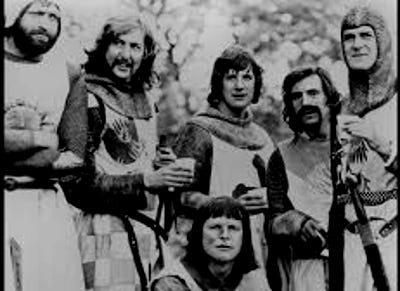
Graham Chapman: King Arthur, Voice of God
John Cleese: Sir Lancelot the Brave, Tim the Enchanter, The Black Knight, peasant turned into a newt, taunting French guard
Eric Idle: Sir Robin the Not-So-Brave-as-Sir-Lancelot, dead Collector, Roger the Shrubber, Brother Maynard
Terry Gilliam: Animator, The Green Knight, Keeper of “The Bridge of Death,” Patsy.
Terry Jones: Sir Bedevere the Wise, Prince Herbert
Michael Palin: Sir Galahad the Pure, Dennis the oppressed peasant, king of Swamp Castle, Leader of the Knights Who Say “Nee!”
Note: “Monty Python and The Holy Grail” and other Python films can be found on Netflix.
Now go away or I shall taunt you a second time!




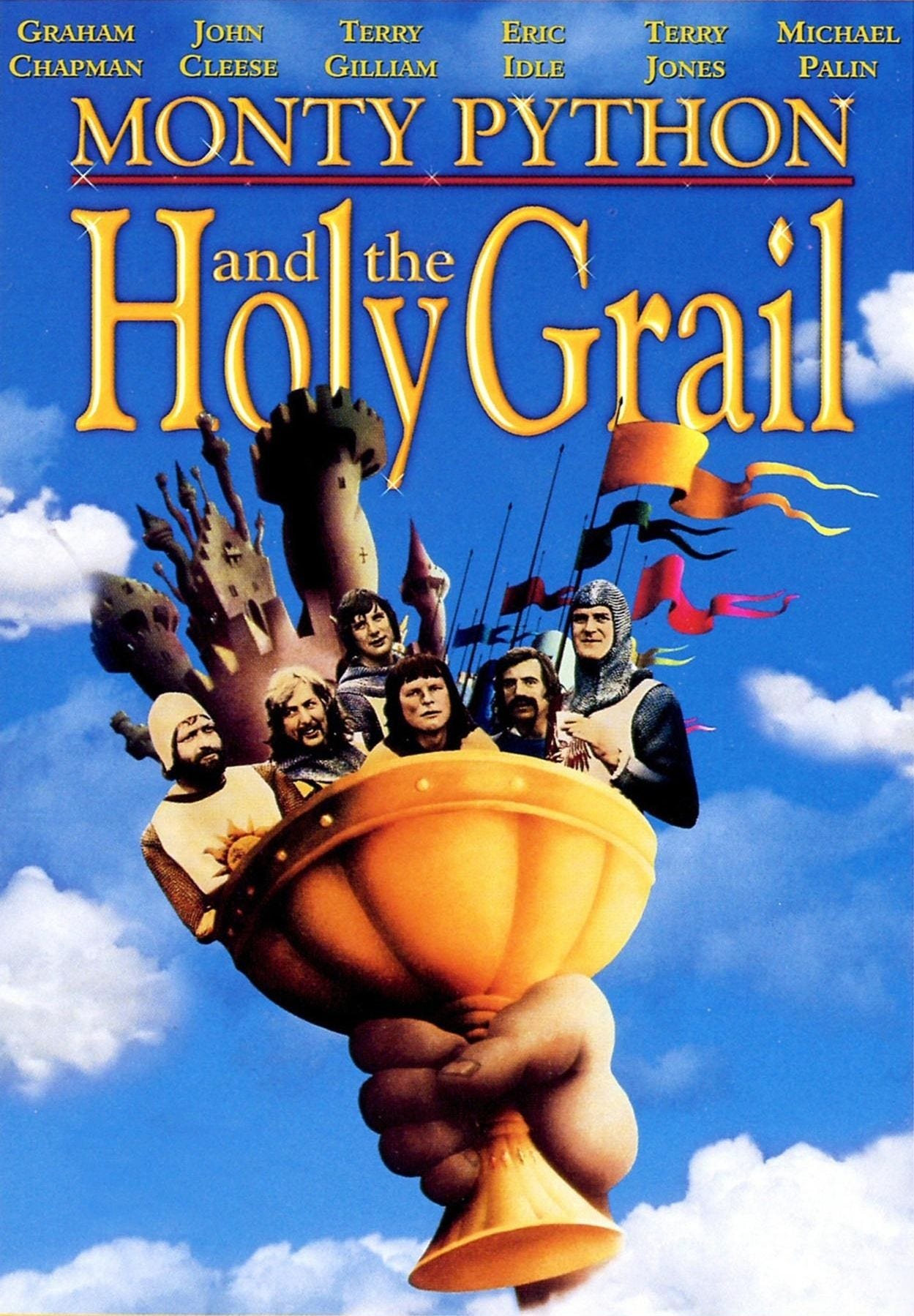

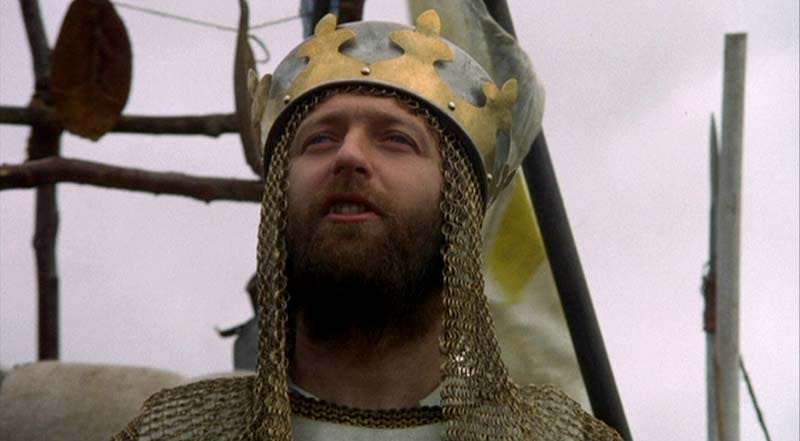

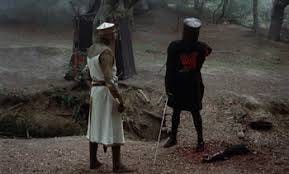
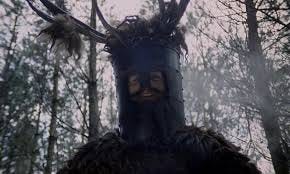
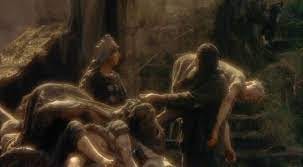

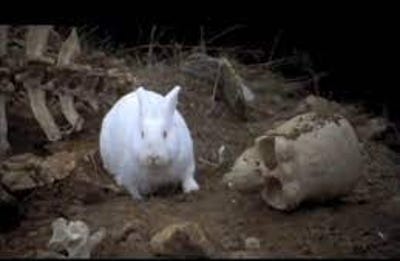
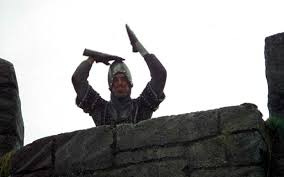

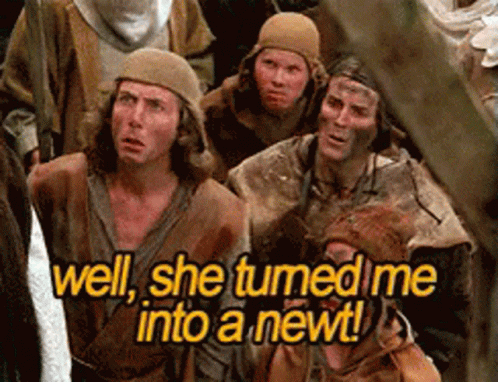
Funniest movie ever. Thanks for the memories!
LOVE Monty Python!!! The Knights of NEE!!!! I actually saw their Broadway show. Not quite the same but was funny. The hurtling cows are also a high point for me.